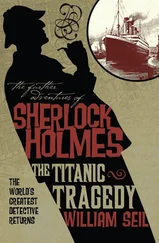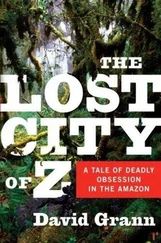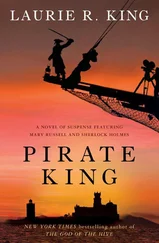He climbed onto a chair and held the contraption up: it was roughly six feet long and cylindrical in shape, with a round hardwood top, a funnel-studded net draped along the sides, and a little glass jar dangling on the bottom. “Whaddaya think, chappies?” O’Shea asked Conway and me.
“What is it?” I asked.
“A giant-squid trap.”
O’Shea pointed to the funnels excitedly, and explained that the para-larvae would swim through them and get trapped inside the net, eventually ending up in the glass jar. This rough-looking device had been carefully conceived: the net was made of extra-fine mesh, which would do less damage to the animals; the board was marine plywood, which would keep the net vertical in the water; and the Coke bottles were exactly the right size to trap the paralarvae. “It’s ugly as sin, I admit, but it should do the job,” he said, adding, “I’m a poor scientist, so it’s a bit of Steve O’Shea invention.”
He spent the rest of the day building a second trap, then announced that it was time to go hunting. The worst of the storm had blown out to sea, but the weather remained volatile, with gusting winds and dangerously high waves. Two surfers had drowned. “We’ll have to do some reconnaissance,” O’Shea said. Before sundown, we took a drive with the trailer, trying to find a safe place to launch the boat. We pulled into an inlet surrounded by volcanic cliffs. “This will have to do,” O’Shea said.
He backed the trailer down the beach, and we put the boat in the water. I climbed on board, and O’Shea and Conway followed. It was cold, but O’Shea was barefoot, and he was wearing only cutoff jeans and a baggy T-shirt. “Righteo, then,” he said, and gunned the engine.
O’Shea had no radar, but he had a navigational system with a small flickering display that signalled the location of the shore and the depth of the sea. It would be our only guide in the darkness.
“It’ll probably be too rough out there for any fishing boats,” O’Shea shouted over the noise of the engine. “But we’re going to need to be careful of container ships. They can come up pretty fast.” It was now twilight, and he squinted at one of the buoys that marked a safe route through the channel.
“What color is that?” he asked me.
“It’s green,” I said. “Can’t you see it?”
“I’m not just deaf,” he said. “I’m color-blind.”
As we left the harbor, it began to rain, and the smooth channel gave way to swells. The boat leaped over the crests, its aluminum hull vibrating.
“A bit rough, ain’t it?” Conway said.
“She’s sturdier than she looks,” O’Shea said of the vessel. He glanced at the forward berth. “Underneath those cushions are the life jackets. You don’t need to wear them, but just so you know where they are.”
The sun disappeared over the horizon, and for a while the sky released a flurry of bright colors, as if it had its own chromatophores. Then it grew dark, and the waves announced themselves not by sight but by sound, as they clapped against the bow. I slipped on my life jacket.
O’Shea said he knew just the spot for hunting, and he stared at the glowing dots on the navigational system. “Where are we going?” I asked.
“There,” he said, pointing into the distance.
I peered over the windshield and saw something shadowy looming over the waves, as if it were the prow of a ship. As we got closer, I realized that it was a large, jagged rock. More rocks became visible, hundreds of them, all jutting skyward. A channel, forty feet wide, flowed between the rocks, and the water stormed through this opening as if it were racing down a chute. O’Shea sped straight ahead. As we approached the rocks, the boat began to tremble while the swells climbed from ten to seventeen feet; the bow plunged downward, the boat sliding wildly in the water. “Hold on, mate,” O’Shea said. “Here comes a big one.”
The boat soared upward, and I felt momentarily suspended in the air, as if I were a cartoon character who had just stepped off a cliff. Then the boat fell straight down, and another wave crashed into it, sending us hurtling backward. My notebook and pen slid to the deck. The peanut-butter-and-jelly sandwiches we had packed for supper tumbled out of their containers. “We just need to make sure they don’t take us broadside,” O’Shea said.
The currents were pulling us toward the rocks, and I could hear the massive waves crashing into them. I was holding a flashlight, and I shone it in front of us: there was a twenty-foot wall of water. I turned around, and discovered that another enormous wall was pressing down on us from behind.
“You won’t find this in New York, will you, mate?” O’Shea said.
For a moment, I wondered if O’Shea was fully in command of his faculties. But we made it through the gap in the rocks, and he skillfully steered the boat into a protected inlet. It was indeed the perfect spot.
We dropped our anchor. O’Shea grabbed his homemade nets, and placed several glow sticks inside them. “The squid are drawn to the light,” he said. He tied the nets to a lead weight, which he then dropped in the water. We watched the light grow dimmer as the traps sank. “Well, let’s see what’s down there,” O’Shea said.
Though oceans cover three-quarters of the Earth-the Pacific alone is bigger than all the continents put together-the underwater realm has remained largely invisible to human beings. For centuries, there was no way for scientists to peer into the depths, no telescope that could gaze into the abyss. (A pearl diver can venture down no more than a hundred feet.) Until the nineteenth century, most scientists assumed that the deepest parts of the ocean-where the temperature was frigid, the pressure intense, and the light minimal-contained no life.
In 1872, the British government and the Royal Society launched the first major oceanic expedition, transforming a two-hundred-and-twenty-six-foot naval warship into a floating laboratory, equipped with microscopes and vats of pickling alcohol. Christened H.M.S. Challenger, the ship, with five scientists, roamed the globe for three and a half years. The crew was constantly dredging the ocean floor for specimens, and the work was repetitive, and brutal; two men went insane, two others drowned, and another committed suicide. The scientists, however, were enthralled with their discoveries. They catalogued more than forty-seven hundred new species-proving, as C. Wyville Thomson, the chief scientist, later noted, that living beings “exist over the whole floor of the ocean.”
The voyage gave rise to the field of oceanography, but it also exposed the twin obstacles that would impede underwater exploration for generations: prohibitive costs and primitive technology. Even when scientists could finance expeditions, their equipment allowed them to study animals only after hauling them on deck-the equivalent of looking at a human corpse, then trying to imagine it alive.
In the nineteen-thirties, two wealthy Americans, Charles William Beebe and Otis Barton, used twelve thousand dollars of their own money to design a hollow steel ball with two quartz peepholes, which they called a “bathysphere,” named after the Greek word for “deep.” The vessel, which was four and a half feet in diameter, was tethered to a ship with a cable; if it snapped, the men inside would die at the bottom of the sea.
In 1934, near Bermuda, Beebe and Barton went down five hundred feet, then a thousand feet more, as greater and greater pressure pushed against the steel walls; they stopped at three thousand and twenty-eight feet. It was far deeper than anyone had ever gone. At one point, Beebe peered out, and spotted something that was at least twenty feet long. Later, in his autobiography, “Half Mile Down,” he wrote, “Whatever it was, it appeared and vanished so unexpectedly and showed so dimly that it was quite unidentifiable except as a large, living creature.”
Читать дальше











